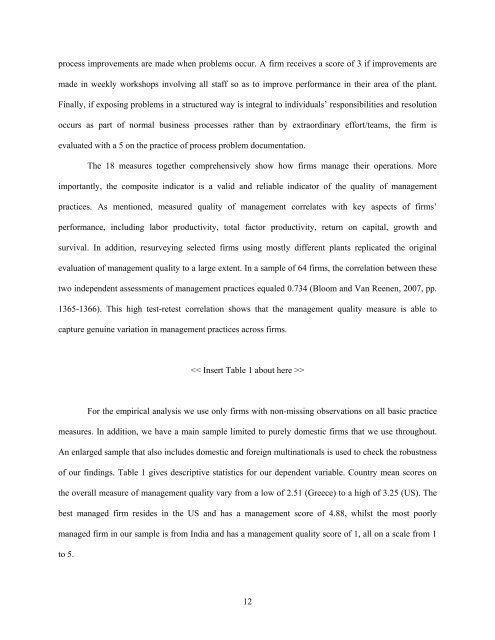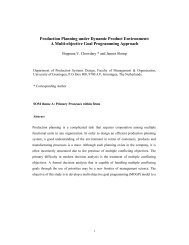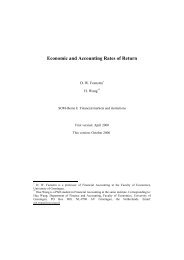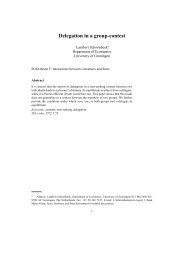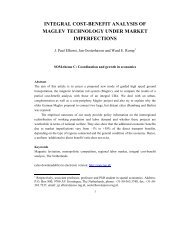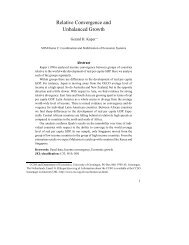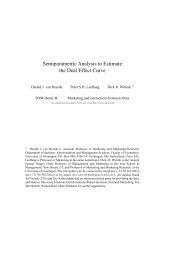Individualism and the cultural roots of management practices
Individualism and the cultural roots of management practices
Individualism and the cultural roots of management practices
Create successful ePaper yourself
Turn your PDF publications into a flip-book with our unique Google optimized e-Paper software.
process improvements are made when problems occur. A firm receives a score <strong>of</strong> 3 if improvements are<br />
made in weekly workshops involving all staff so as to improve performance in <strong>the</strong>ir area <strong>of</strong> <strong>the</strong> plant.<br />
Finally, if exposing problems in a structured way is integral to individuals’ responsibilities <strong>and</strong> resolution<br />
occurs as part <strong>of</strong> normal business processes ra<strong>the</strong>r than by extraordinary effort/teams, <strong>the</strong> firm is<br />
evaluated with a 5 on <strong>the</strong> practice <strong>of</strong> process problem documentation.<br />
The 18 measures toge<strong>the</strong>r comprehensively show how firms manage <strong>the</strong>ir operations. More<br />
importantly, <strong>the</strong> composite indicator is a valid <strong>and</strong> reliable indicator <strong>of</strong> <strong>the</strong> quality <strong>of</strong> <strong>management</strong><br />
<strong>practices</strong>. As mentioned, measured quality <strong>of</strong> <strong>management</strong> correlates with key aspects <strong>of</strong> firms’<br />
performance, including labor productivity, total factor productivity, return on capital, growth <strong>and</strong><br />
survival. In addition, resurveying selected firms using mostly different plants replicated <strong>the</strong> original<br />
evaluation <strong>of</strong> <strong>management</strong> quality to a large extent. In a sample <strong>of</strong> 64 firms, <strong>the</strong> correlation between <strong>the</strong>se<br />
two independent assessments <strong>of</strong> <strong>management</strong> <strong>practices</strong> equaled 0.734 (Bloom <strong>and</strong> Van Reenen, 2007, pp.<br />
1365-1366). This high test-retest correlation shows that <strong>the</strong> <strong>management</strong> quality measure is able to<br />
capture genuine variation in <strong>management</strong> <strong>practices</strong> across firms.<br />
><br />
For <strong>the</strong> empirical analysis we use only firms with non-missing observations on all basic practice<br />
measures. In addition, we have a main sample limited to purely domestic firms that we use throughout.<br />
An enlarged sample that also includes domestic <strong>and</strong> foreign multinationals is used to check <strong>the</strong> robustness<br />
<strong>of</strong> our findings. Table 1 gives descriptive statistics for our dependent variable. Country mean scores on<br />
<strong>the</strong> overall measure <strong>of</strong> <strong>management</strong> quality vary from a low <strong>of</strong> 2.51 (Greece) to a high <strong>of</strong> 3.25 (US). The<br />
best managed firm resides in <strong>the</strong> US <strong>and</strong> has a <strong>management</strong> score <strong>of</strong> 4.88, whilst <strong>the</strong> most poorly<br />
managed firm in our sample is from India <strong>and</strong> has a <strong>management</strong> quality score <strong>of</strong> 1, all on a scale from 1<br />
to 5.<br />
12


